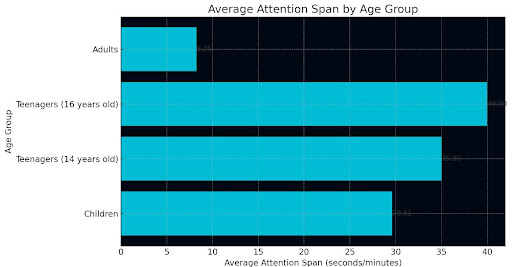Constant Connection, Constant Distraction
These days, technology is a huge part of everyday life.
Phones, social media, and constant notifications make it easier than ever to stay connected — but they also make it harder to stay focused. For students, this can mean struggling to pay attention in class, finish homework, or even have meaningful conversations. Teachers are noticing the change, students are feeling the impact, and schools are trying to figure out what to do about it.
A Growing Problem
It’s no secret that attention spans are shrinking.
In fact, the average attention span is now just 8.25 seconds — shorter than a goldfish, according to Samba Recovery. CNN even reported that the time spent focusing on one screen has dropped from 2.5 minutes in 2004 to just 47 seconds today. The constant pull of phones and social media makes procrastination easier and productivity harder to maintain.
The Classroom Impact
Miss Rebekah McCord, an English teacher at Brunswick High School, sees the consequences up close, especially when it comes to reading habits.
“Phones are impacting the attention span of both teenagers and adults in society. People are so used to scrolling quickly that some are losing the ability to focus on longer text. Reading endurance is an essential skill for higher education and many jobs.” Miss McCord says, “In addition, phones increase everyone’s procrastination and make us less productive. Imagine if we could take all of that time we spend on phones and use it for good: discovering cures for diseases, building stronger relationships, or even solving the mental health crisis.”
Mr. Jayson Mobley, another teacher observes that students often “navigate away from the resources that they are to be accessing and instead are doing such things such as playing games or watching YouTube.” Mr. Mobley says, “With constant digital distractions, productivity takes a hit, leaving students struggling to keep up. The internet just like any form of technology can provide wonderful benefits as long as it is used properly. The internet has so much information that is readily available for the students but it is up to the students to locate the information, understand the information and then process it for it to be useful.”
Students Speak Out
For many students, staying focused feels like an uphill battle.
The temptation to multitask — switching between assignments, social media, and games — can make it difficult to complete tasks. The impact of constant digital stimulation isn’t lost on students. Estefani Alvarado, a sophomore, admits that focusing has become harder.
“I think it’s made it kind [of] hard because people tend to not really concentrate on the task at hand but rather not finish their things.”
However, some students are finding ways to push back against these distractions. Mecciah Keitt, a senior, has developed her own system to stay on track.
“Specific table in my house that everybody knows to not bother me at; headphones on, noise canceling on, and some relaxing music; only school-related stuff and maybe a snack on the table; phone on do not disturb and put in a place furthest from my easy reach; take timed breaks; 1 hour working, 3-minute break.”

Average Attention Span by Age Group, according to Samba Recovery.
Image created using Canva (Elizabeth Lopez Guzman)
Finding Balance
The internet and social media aren’t going anywhere.
These tools can either help or hurt, depending on how they’re used. Finding balance might mean setting boundaries with devices, creating distraction-free spaces, or taking regular breaks to reset.
In this hyper-connected world, the challenge lies in staying productive, learning effectively, and nurturing meaningful relationships while managing the constant pull of technology.



Mrs. Kowalski • Mar 26, 2025 at 12:00 pm
I appreciate hearing student perspectives on this topic.